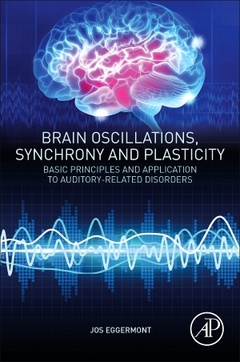Brain Oscillations, Synchrony and Plasticity Basic Principles and Application to Auditory-Related Disorders
Auteur : Eggermont Jos J.

Brain Oscillations, Synchrony and Plasticity: Basic Principles and Application to Auditory-Related Disorders discusses the role of brain oscillations, especially with respect to the auditory system and how those oscillations are measured, change over the lifespan, and falter leading to a variety of psychiatric and neurological disorders. The book begins with a description of these cortical rhythm oscillations and how they function in both the normal and pathological brain. It explains how these oscillations are important to auditory, executive and attention brain networks and how they relate to the development, production and deterioration of speech and language.
In addition, treatment of malfunctioning cortical rhythms are reviewed using neuromodulation, such as transcranial magnetic, direct current, random noise, and alternating current stimulation, as well as focused ultrasound. The book concludes by describing the potential role of oscillations in dyslexia, autism, schizophrenia and Alzheimer?s disease.
SECTION 1 Oscillations1. Brain rhythms, neural synchrony and networks in health and disease2. The gamma, beta and theta rhythms and nested oscillations3. The alpha and delta rhythms and their interaction with other brain rhythms4. Brain rhythms underlying perception and cognition
SECTION 2 Synchrony5. Neural spike-firing synchrony and population activity6. From oscillation synchrony to neural networks
SECTION 3 Plasticity7. Rhythms and networks in the hearing and deaf brain8. Neuromodulation of brain rhythms and connectivity9. Lifespan changes in brain rhythms and networks
SECTION 4 Disorders10. Brain rhythms and connectivity changes in tinnitus patients11. Developmental disorders: Dyslexia and Autism12. Schizophrenia, and Alzheimer’s Disease
- Introduces readers to brain imaging methods such as structural and functional magnetic resonance imaging, EEG and magnetoencephalography, in the study of brain oscillations, synchrony and networks of the normal and pathological brain
- Highlights the role of brain oscillations in perception and cognition, in particular with respect to the auditory system, speech and language
- Describes lifespan changes, from preterm to senescence, of brain oscillations, brain networks and how they relate to the development and deterioration of speech and language
- Explains the effects of hearing loss on neural network change in the auditory and non-auditory networks such as the default mode-, the salience-, the executive- and attention networks
- Illustrates the breakdown of network connections in auditory-related disorders such as tinnitus and in psychiatric disorders with a strong auditory, speech and language component
Date de parution : 01-2021
Ouvrage de 266 p.
15x22.8 cm
Thèmes de Brain Oscillations, Synchrony and Plasticity :
Mots-clés :
Neural networks; Cognition; Connectome; Neuromodulation; Life-span Changes; Auditory Disorders; Hearing Loss; Tinnitus



